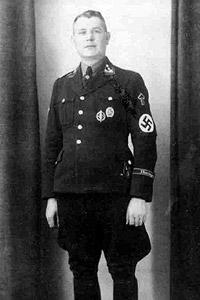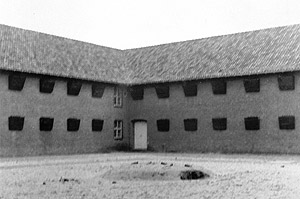Adam Grünewald (1902-1945)
Introduction
Adam Grünewald was a rather insignificant person within the SS, who managed, despite his limited abilities, to get promoted to SS-Sturmbahnführer and commander of the Vught concentration camp in the Netherlands. There he was the one to blame for the Bunker tragedy, which happened during the night of the 15th to 16th of January 1944. Ten female prisoners died that night of suffocation, after they had been detained with 64 other fellow prisoners in a cell that was too small and had a poor ventilation system. This terrible incident led to his resignation as camp commander.
Pre-war carreer within the SS
Adam Grünewald, born on the 20th of October 1902 at Frickenhausen near Würzburg in a family of a carpenter, made a dashing career in the Schutzstaffel (SS). After World War One he served as a foot soldier from 1919 to 1931 at the Reichswehr, and got promoted to the rank of Feldwebel (sergeant). After he finished his service in the army, he was active at the Freikorps, and on the 1st of May 1931 he became a member of NSDAP (Nazi party) and the SA (Sturmabteilung or a paramilitary of Nazi Germany). On the 12th of September 1934 he left the SA for the SS. His rank of SA-Obersturmbannführer was changed to that of SS-Sturmhauptführer (which later that year would be called SS-Hauptsturmführer). He served at the Politische Bereitschaft (the precursor of the Waffen-SS) in Saxony, before on the 10th of November 1934 he was transferred to the concentration camp Lichtenburg, nearby Wittenberg in the Eastern Germany. There he was leading a company of guards. He was not the best in this task, because on the 13th of July 1935 Theodor Eicke, the Inspector of Concentration Camps, asked the SS-Personalamt to transfer Adam Grünewald somewhere else. According to him, Grünewald was "not able to manage his group well and to bring it on a high military level. […] Though he was a soldier of the Reichswehr […] he lacks the ability to be deployed as an officer at the barracks of the SS." In case no other post could be found for him, he would be employed for any civil job. It took until the 10th of July, 1937, before another function was found for him.Though Eicke stated that Grünewald was unsuitable for his job, he was appointed again as the leader of a company, this time in the SS-Totenkopfverbände "Thuringia", an armed unit that was used, among other things, for monitoring Buchenwald. Here too, he attracted attention through his incompetence: he was considered unsuitable to serve as an officer on the front, and to manage a post in a concentration camp "he lacked the hardness necessary for dealing with state enemies." That's why he was registered for a training to become a SS-Sturmbannführer in the Allgemeine-SS, the non-military branch of the SS. Especially in the intellectual field, Grünewald did not excel during the training he followed in Dachau from February 26, 1938. In his evaluation report from the 8th of April they noted that he indeed was trustworthy and had a good will and a friendly attitude, however because of his "strongly limited mental ability [...] a longer education and training at an officer's school will hardly have the desired result". He was found capable of training small units, but he was not eligible for promotion to SS-Sturmbannführer.
Then for a short time he was working for the Allgemeine-SS in Austria, until in 1938 he was transferred to Dachau concentration camp, where Richard Glücks, successor to Eicke, promoted him to the second Schutzhaftlagerführer. Again they had to admit, this job was not suitable for him. His immediate superior in Dachau found that Grünewald showed "little interest" for his work. "Grünewald won't become a self-reliant Schutzhaftlagerführer, because he does not care about anything and does not show a sense of responsibility." Because no other position could be found for him, he continued working at this post for a while.
World War Two
The war brought new perspectives with it for Grünewald's career. In November 1939 the young SS member (who in his young years was educated as a baker) was assigned to a post of bakers company leader of the SS-Totenkopf-Division. On this position he participated in a campaign in the West and then arrived at the Eastern Front. Finally he was praised: on the 26th of July 1940 he was awarded with the Iron Cross (Eisernes Kreuz) second class, and on the 2nd of August 1941 his commander ordered to get him promoted to SS-Sturmbannführer: "Because of the excellent leadership of the company [by Grünewald] this unit always and in every situation fulfilled the orders given to it in a professional manner. Besides, H’Stuf Gr. succeeded in bringing the military company to a very respectable level in a world-view and sporting way."
Camp commander in Vught
The order was approved, and on the 1st of September it came into force. Though it seemed he finally found his place, Grünewald was transferred to Amtsgruppe D of the SS-WVHA starting the 20th of November 1942, to be responsible for the management of the concentration camp system. After first working as Schutzhaftlagerführer in Sachsenhausen he was appointed as a commander of the concentration camp Herzogenbusch in 1943, better known as camp Vught.[1] He replaced the previous camp commander, SS-Hauptsturmführer Karl Walter Chmielewski, who got fired in October 1943 as guilty of embezzlement.[2]
It wouldn't take long before Grünewald too would get fired and had to answer for the court because of a serious incident, the so-called Bunker tragedy, that happened in the night of 15th to 16th of January 1944 in his camp. He ordered to detain 74 female prisoners in cell 115, because they had protested against the detention of the fellow prisoner. The area of the 9 m² had a poor ventilation, and ten women suffocated during the interment. The news of the tragedy quickly got outside the camp and would be described in details by the Dutch illegal press. This was a thorn in the flesh of Nazi leadership in the Netherlands, as such incidents could fuel the resistance there. Measures were taken to prevent further negative publicity. The camp commander and his assistant SS-Obersturmführer Hermann Wicklein were summoned for the SS court martial.
Sentence and death
The lawsuit was handled by the X SS- and Police Court in The Hague, but took place in Velp, in the province of Gelderland, where the court moved to in February 1944. The sentence was mild, because the court was convinced that Grünewald "didn't wish for the death of ten women". They pointed out the years of Grünewald's service in the Reichswehr and his military commitment to the SS where he would "stick up for his mates". The court had "the full conviction" that Grünewald's "deed did not come in the slightest out of dishonorable motives." Admittedly he was given fault for the death by guilt, but he got off with three and a half years imprisonment. Wicklein got off with six months.
Both men didn't spend long in the prison, because in March already they were freed as ordered by Heinrich Himmler. Grünewald was allowed to spend eight days in March with his family and after that he followed a short training in Wrocław. With the lowest SS-rank, he then served in the 3rd SS-Panzer-Division "Totenkopf" starting June. In October 1944 he got the rank of SS-Obersturmführer, two ranks lower than he had as camp commander. We assume that he fell on the 22nd of January 1945 at the front in Hungary.[3]
Notes
- Personnel file of Adam Grünewald. Das Bundesarchiv.
- Klee, E., Das Personenlexikon zum Dritten Reich, p. 91: In October 1943, Chmielewski was dismissed from his post and arrested. In 1944 he was sentenced to 15 years in prison by an SS court. Heinrich Himmler, however, overturned this judgment. On the 11th of April 1961 he was sentenced to life long imprisonment by the Landgericht Ansbach for crimes in Camp Gusen.
- Personell file of Adam Grünewald. Das Bundesarchiv; Klee, E., Das Personenlexikon zum Dritten Reich, p. 206; MacLean, F.L., The Camp Men, p. 93.
Definitielijst
- concentration camp
- Closed camp where people are being held captive that are considered to be anti- social, enemies of the state, criminal or unwanted individuals. These groups mostly do not get a fair trial or are condemned to doing time in a camp.
- Dachau
- City in the German state of Bavaria where the Nazis established their first concentration camp.
- Eisernes Kreuz
- Iron Cross. German military decoration.
- Freikorps
- German paramilitary units established directly after the Great War by former front soldiers. These groups were often named after their commander. Freikorps formed the basis of the eventual SA or Sturmabteilung.
- Iron Cross
- English translation of the German decoration Eisernes Kreuz.
- Nazi
- Abbreviation of a national socialist.
- Reichswehr
- German army during the Weimar republic.
- resistance
- Resistance against the enemy. Often also with armed resources.
- Schutzstaffel (SS)
- The Schutzstaffel commanded by Heinrich Himmler was a very powerful organisation within the Third Reich. The original goal of the SS was to protect Adolf Hitler and other Nazi’s but soon the SS was deployed for several military, security and police tasks. The SS guarded inter alia the concentration camps and manned the Einzatzgruppen. The armed branch of the SS was the Waffen-SS.
- Sturmabteilung
- Storm detachment. Semi-military section of the NSDAP. Founded in 1922 to secure meetings and leaders of the NSDAP. Their increasing power was stopped during “The night of the long knives”, 29 and 30 June 1934.
- Totenkopf
- “Death’s head”. Symbol that was used by the SS. Also the name of an SS Division.
- Totenkopfverbände
- Death’s head regiments. Special formation inside the Schutzstaffel (SS) that was deployed to guard concentration camps.
- Waffen-SS
- Name of Military section of the SS.
- Würzburg
- German short range radar. Was used to guide searchlights, FLAK and guiding German night fighters.
Information
- Article by:
- Kevin Prenger
- Translated by:
- Liza de Groot
- Published on:
- 19-01-2025
- Feedback?
- Send it!





